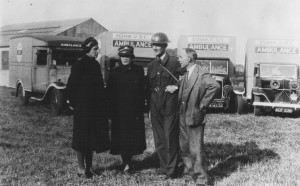Egham’s Dad’s Army – Civil Defence in 1939
 Among the extensive documents relating to the Second World War held by Egham Museum is a fascinating Civil Defence report. Royal Holloway student and Museum volunteer, Alice Castle picks up the story:
Among the extensive documents relating to the Second World War held by Egham Museum is a fascinating Civil Defence report. Royal Holloway student and Museum volunteer, Alice Castle picks up the story:
This document originates from the town of Egham and is a report entitled Civil Defence Exercise. The exercise took place just before the outbreak of the Second World War on 29th July 1939 but the document was produced on 8th August 1939. This report was produced during a period of heightened anxiety and tensions over airborne attacks that were expected to affect Britain imminently. The report was compiled by the officer in charge of the report centre, Mr E.W. Root, and is made up of 12 different simulated incidents that took place throughout Egham from 21:00-24:00 hours. All the incidents centred around a simulation of a high explosive bomb going off which caused fires and casualties. The report ends with a round up of observations from the report centre and from the Chief Warden.
Casualty Services Umpire’s Report Incident 1: Two casualties (fractured ribs and burnt foot) did not turn up. A small boy volunteered for the latter injury and was treated.
In December 1937 the Air Raid Precaution Act made it compulsory for all local authorities recruit volunteers for civil defence and the emergency services, amongst other things including distributing gas masks. Whilst these wardens were made fun of during the first weeks of the war when there were no German airstrikes, once the attacks began their job was necessary for keeping civilians safe. The overall report shows how unprepared the wardens, police and emergency services were for the tasks in hand. However, observations made by the Chief Warden at the end of the report states that whilst the wardens came under a lot of criticism many lacked confidence as it was their first time undertaking a practical test of any kind.
Observations by the Chief Warden: The outstanding weakness was a disinclination by Wardens to assert themselves and to take a grip of the situations that confronted them.
Each incident details when the incident occurred, when the message from each service involved was received at the report centre, and the umpires’ reports on how each service undertook the task in hand. Some of the incidents, such as incident 5, are very detailed, and this is perhaps as a result of the positive view of how the incident took place.
Wardens Umpire’s Report Incident 5: The Wardens functioned well. The Senior Warden was particularly efficient and displayed a good deal of initiative.
Overall, the purpose of the report was to test the civil defence and emergency service volunteers in practice incidents that they thought could occur in Egham. The high street of Egham was bombed in WW2, so reports such as this one would have been necessary in improving the services in Egham to keep everyone safe. There are lots of amusing anecdotes in the report, almost like Egham’s own Dad’s Army. However, the significance in the report cannot be forgotten, as exercises such as these were invaluable to the volunteers and civilians alike in preparing for WW2.
Casualty Service’s Umpire Report Incident 8: No search was made for more casualties and a hysterical woman would have been left if not pointed out.
Alice Castle is in her third year of studying History and along with fellow volunteer Gavin Bedford is working to make some of the hidden histories of Egham contained in our archive more visible.

